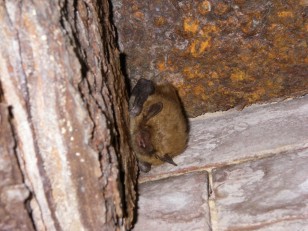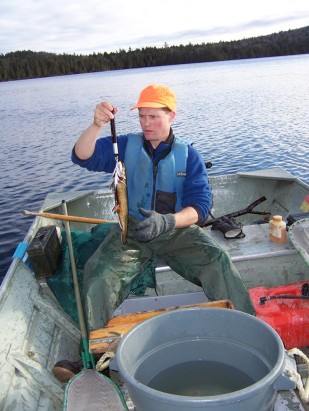This story was originally published on our new Medium blog platform
What do frosted elfin butterflies have in common with Blackhawk helicopters?
Both can hover in place, maneuver erratically in flight, and are secured behind locked doors by the New Hampshire Army National Guard.
And if not for the Blackhawks, the elfin there might have remained under the radar.

A male and a female elfin linked up to mate. (Heather Siart)
In 2000, the New Hampshire Army National Guard was preparing to replace its 1970s era UH-1 helicopters (“Hueys”) with modern equipment: nine Blackhawks and a C-12 fixed-wing turboprop plane. But there was a problem. “The existing facility couldn’t support the new aircraft,” explained Arin Mills, conservation specialist for the New Hampshire Army National Guard.
That meant they needed to build a new facility, which demanded more square footage than was available on the state military reservation in Concord.
When the Guard identified a suitable place to build on the corner of the nearby Concord Municipal Airport, they encountered another problem: the parcel contained pine barrens, a rare type of habitat characterized by sandy soil and fire-dependent conifers. Another butterfly of interest, the endangered Karner blue, had been spotted there before.
“As a federal entity, we need to consider impacts to pine-barren species like moths and butterflies,” Mills said.
And so the Guard worked with other federal entities — the U.S. Fish and Wildlife Service, which is responsible for endangered species, and the Federal Aviation Administration, which is responsible for airports — as well as with New Hampshire Fish and Game and the city of Concord, to land on a solution. The Guard would build a new aviation facility at the municipal airport, and build 15 acres of new pine-barren habitat on the grounds of the state military reservation. The habitat would support the state endangered frosted elfin butterfly, and the federally endangered Karner blue butterfly.

The Army Aviation Support Facility: the building that initiated the consultation leading to the 15-acre habitat restoration project on the state military reservation. Can you spot the Blackhawk helicopter? (N.H. Army National Guard)
It was no small task. “We tore down some barracks, tore up roads, and reconfigured the entire reservation to get to the 15 acres,” Mills said. “Construction was still happening when I started here in 2004, and it wasn’t complete until 2006.” It’s worth the effort for the National Guard. Moving the butterflies toward recovery may lead to less stringent mitigation requirements in the future.
When the heavy equipment was finally hauled away, they broke out the tree spades and started planting: first pitch pines, later lupine, which frosted elfin and Karner blue need to survive. Then they started annual surveys, watching and waiting for both butterflies to arrive.
New recruits
In the meantime, some butterflies had already moved in. Not to the barrens — to the barracks.
At the same time the Guard was looking for a new place to house helicopters, New Hampshire Fish and Game was looking for a new place to house butterflies.
In the 1990s, surveys showed New Hampshire’s population of Karner blue butterflies was experiencing a long-term decline. Scientists feared that without direct intervention the species could disappear from the Concord area, so the state worked with the U.S. Fish and Wildlife Service to explore the possibility of starting captive-rearing program.
Among the needs was a secure place to raise them.
Cue the Army National Guard. As part of the mitigation plan for the new aircraft facility, the Guard gave New Hampshire Fish and Game funds for 300 acres of habitat restoration, and a 1,600-square-foot space on the state military reservation.
“They had an old barracks on the reservation that they were no longer using,” said Heidi Holman, project lead for species programs at New Hampshire Fish and Game. “We put a greenhouse roof on top, and began propagating and releasing butterflies.”
At first the primary emphasis was on Karner blue. To date, more than 30,000 have been released into the wild as a result of New Hampshire’s captive-rearing program. However, the state had also been monitoring frosted elfin periodically since the early 2000s, and had attempted to breed them in captivity as well. “They are very territorial and tricky in captivity,” Holman explained.
But with growing concern about elfin throughout the region, biologists have doubled down. The U.S. Fish and Wildlife Service will be reviewing the butterfly’s status in 2023, leaving a small window to determine whether it may need similar federal protection to the Karner blue butterfly.
“Building off many years of experience, techniques, and protocols that we have used to re-establish a population of Karner blue in Concord, we wanted to use our lab to contribute to frosted elfin recovery as well,” Holman said.
I love the smell of lupine in the morning

A sprig of wild blue lupine, which both frosted elfin and Karner blue butterflies depend upon to survive. (Heather Siart)
Now with funding from the Service’s Wildlife and Sport Fish Restoration Program, New Hampshire is helping to fill in some of the blanks about elfin.
“Wing measurements, larval measurements, sexing, what exactly they are eating — our main focus is collecting life history information that hasn’t been collected before,” explained Heather Siart, who was hired by Fish and Game with WSFR funding to spearhead the elfin reconnaissance effort.
While they still haven’t figured out how to get elfin to mate in captivity, they have figured out how to get them to lay eggs. “We use a red Solo cup with one cotton ball soaked with honey, one soaked with nectar, and a sprig of lupine, which spurs them to lay,” Siart said.
From just 15 females collected this spring, they got more than 1,000 eggs, 80 percent of which hatched, 50 percent of which they released back into the wild. “That’s a good hatch rate, and now we have well over 500 that we will overwinter until they emerge in the spring,” Holman said.
A few good elfin
The elfin raised on the military reservation are likely to find good homes nearby, as are their offspring. Last May, more than 70 elfin were captured and marked in a single day at the Concord airport, a high for the species at this site.
More than a record, it’s an indication; the habitat restoration work is paying off. It’s also catching on. Since 2001, the partnership between the state, the Guard, the Service, the FAA, and the city, has expanded to include the neighboring industrial gas company, Praxair, Inc., which has restored habitat and planted lupine on their land too.

A frosted elfin caterpillar on a lupine pod in front of the Joint Force Headquarters on the state military reservation. (N.H. Army National Guard)
Someday, elfin will no longer need to be sheltered in the barracks, but they might be able to live right in its footprint. “It’s standing in the middle of our habitat area,” Mills explained. “When the facility is no longer needed, we’ll tear it down.”
In the meantime, the butterflies are well protected. You need security clearance just to get onto the reservation.
Not to mention elfins’ built-in security system. Just like Blackhawk helicopters, they are camouflaged to blend into their surroundings.
“For a long time, I think frosted elfin were overlooked,” Mills said. “Now you can’t go out on the reservation on any day during flight period and not see one.”
Thanks to coordination and collaboration with public and private partners, more than 185 species in the eastern United States have recovered, been downlisted, or did not need listing under the Endangered Species Act. The effort to conserve at-risk wildlife and recover listed species is led by the Service and state wildlife agencies in partnership with other organizations. Our use of conservation incentives and flexibilities to protect wildlife, reduce regulations and keep working lands working has drawn bipartisan support from Congress.

























